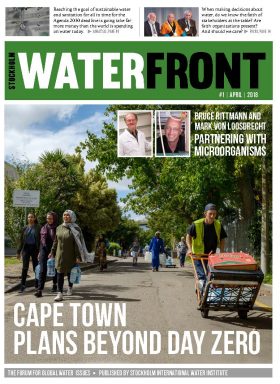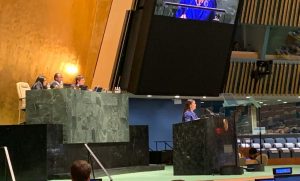Stockholm WaterFront no 1, 2018
Last summer, WaterFront covered the then-emerging water crisis in Cape Town. Since then, the city has seen Day Zero warnings, international media spotlights, and water rationing. In this issue we revisit the South African metropolis to see how it is coping with the new normal.

What are Capetonians doing to deal with water scarcity not only today but in the long run? And has the drought changed citizens’ attitudes towards water? Read the cover story on page 4.
The 2018 Stockholm Water Prize laureates, Professor Bruce E. Rittmann and Mark van Loosdrecht, show us how we can partner up with microorganisms to take the “waste” out of “wastewater”. We asked them about their current work and upcoming inventions. Read their interview on page 10.
Summary
Last summer, WaterFront covered the then-emerging water crisis in Cape Town. Since then, the city has seen Day Zero warnings, international media spotlights, and water rationing. In this issue we revisit the South African metropolis to see how it is coping with the new normal. What are Capetonians doing to deal with water scarcity not only today but in the long run? And has the drought changed citizens’ attitudes towards water? Read the cover story on page 4.
The 2018 Stockholm Water Prize laureates, Professor Bruce E. Rittmann and Mark van Loosdrecht, show us how we can partner up with microorganisms to take the “waste” out of “wastewater”. We asked them about their current work and upcoming inventions. Read their interview on page 10.
Three years into Agenda 2030, it’s still not clear how to mobilize sufficient resources to achieve the goal of sustainable water and sanitation for all. On page 8, this issue’s Analysis looks at how the private sector can help fill the financing gaps.
Religious beliefs influence many people in their daily decisions around water. Yet, they are rarely at the core of our discussions on water. How come and which role do faith organizations play? Read more on page 13.
In the Last Word, Malin Falkenmark reminds us that water scarcity requires far more attention than it is currently getting. More on page 15.
Three years into Agenda 2030, it’s still not clear how to mobilize sufficient resources to achieve the goal of sustainable water and sanitation for all. On page 8, this issue’s Analysis looks at how the private sector can help fill the financing gaps.
Religious beliefs influence many people in their daily decisions around water. Yet, they are rarely at the core of our discussions on water. How come and which role do faith organizations play? Read more on page 13.
In the Last Word, Malin Falkenmark reminds us that water scarcity requires far more attention than it is currently getting. More on page 15.
Enjoy the read!



